Adding Fall Color to your backyard landscape

In the New York Metro area, we are lucky to be treated to a fireworks display of autumn colors. Few places have the variety and intensity of color that we see in the foliage of the Northeast. Aside from entertaining us, nature also has another purpose in painting so many trees with these intense hues.
Different fall colors occur for different reasons. The orange and yellow pigment in leaves doesn’t suddenly appear – it has been there all along, only disguised by the intense green of chlorophyll.
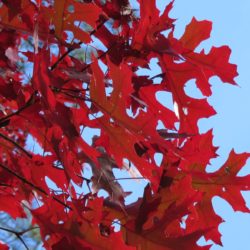
Scarlet Oak
During the summer, trees use their leaves to make glucose, which gives them energy to use and to store for the winter. Leaves are solar panels for trees; the leaves of deciduous trees add tremendous surface area for collecting sunlight. As winter approaches, trees can no longer replenish the moisture that evaporates from their canopies, so they turn off the tap and starve the leaves of water. As the green chlorophyll ceases production and fades, the yellows and oranges that have been there all along become visible.
Reds and purples come from anthocyanins that form when glucose is trapped in the leaves. There are theories about what benefit this provides to the tree. Some scientists feel it allows leaves to remain on the branches longer, providing the tree with added nutrients. Others think that as red and purple leaves decay the anthocyanins make the ground inhospitable to competing species. Brown leaves contain large deposits of tannins, a waste product of photosynthesis. Here’s a list of trees that can add color to the fall landscape in your yard.
Trees that change color in fall in our region
American Elm – The American elm tree produces leaves of yellow, orange and copper hues in the fall season. Tolerant to wind and heat, this tree can grow up to a height of 80 feet, offering ample shade at full maturity. Full sun is required for this tree. It can grow in a wide range of soil textures. If you are considering planting this species, a disease resistant variety is essential.
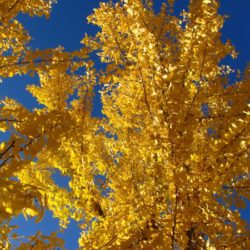
Ginkgo
Black Locust – Black locust produce oval-shaped leaves that turn into a clear pale yellow with the fall season. Best grown in sandy, rocky soil, this tree can grow up to 80 feet tall. Although recently categorized as an invasive species in the State of New York, they are prolific throughout our landscapes and forests.
Ginkgo – Known as the “Maidenhair tree” for the shape of their leaves, Ginkgo trees produce leaves of a beautiful yellow-gold color in the fall. Long-lived and known to be drought tolerant, these trees typically have an umbrella shape and can grow to be about 80 feet tall. Although not native to our region, Ginkgo is a great urban-tolerant tree that is under-utilized in our landscapes.
Katsura – Katsura trees produce heart-shaped leaves of a gorgeous pinkish-yellow or apricot color. With the ability to grow up to 60 feet tall in full or partial sun, it is commonly found in residential areas and parks. Katsura trees also produce a “spicy-sweet” fragrance, which can supposedly be compared to brown sugar.
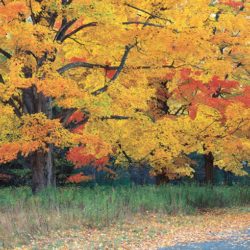
Sugar Maple
Sugar Maple – Known as the “quintessential” fall tree, the Maple produces leaves that turn orange, scarlet and yellow with the change in season. The sugar maple, the state tree of New York whose sap is used to make maple syrup is common throughout Westchester County. It can grow up to 120 feet tall and almost just as wide, given the space.
Redbud – The Redbud tree produces heart-shaped leaves that turn yellow or reddish-purple (depending on the variety) with the fall season. Best grown in moist areas rich with soil, this tree grows at a medium rate and can reach a height of up to 30 feet at full maturity. The Redbud is a great understory ornamental tree that needs proper pruning to improve structure.
Sassafras – Producing leaves of yellow, deep orange and scarlet that grow in a round shape, the medium-to-fast growing Sassafras tree can reach a height of up to 60 feet at full maturity. Full sun and partial shade are best for this tree, which has some tolerance to drought and salt. Sassafras also produces an aroma that smells heavily of licorice. You won’t typically find this tree in the nursery trade as it does not transplant well, but it is common in our woodlands.
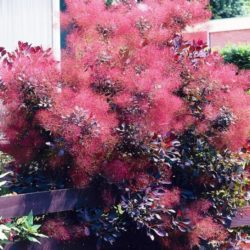
Smokebush
Smokebush – This shrub produces yellow flowers, which turn into a deep crimson red with the change of season. Named for their flowers’ “fluffy” appearance, which resembles a cloud of smoke growing over the plant, the oval-shaped shrub grows up to 15 feet tall at full maturity. It is best grown in dry, infertile soil.
Black Birch – Black Birch trees have a shiny reddish-brown bark and produce leaves of a dark yellow color. They are commonly seen around residential areas and parks. Best grown in full sunlight, this tree can grow to a height of 40-50 feet at full maturity. Black birch trees also produce a sap of their own, which can be used to brew homemade birch soda.
Sweetgum – These trees produce leaves of yellow, orange, red, and even purple color. The “glossy, star-shaped leaves” are known to glow in the sun, and stay longer on the tree, rather than fall off throughout the season. Full sun is needed for the sweetgum tree to maintain growth, which can reach a height of 60-75 feet at full maturity. (Owners sometimes complain about the sharp balls that litter their yards — which are the fruit seed of this species.)
Witch Hazel – This tree produces leaves of a yellow to yellow-orange color in the fall. Grown best in full sun and partial shade, this tree can tolerate a variety of moisture conditions. Witch Hazel can be considered as either a large shrub or small tree. It grows at a medium rate, and can reach up to 15-30 feet at full maturity.
Other trees in our region that produce beautiful fall colors include scarlet oak, red oak, American beech, red maple, Japanese maple, and the American dogwood. Gathering leaves with family and friends, especially children, is a great family outdoor activity for the fall. See how many of the trees described here your group can identify.
When Color Change is a Warning Sign
Although color change is natural for deciduous trees, premature color change is often a warning sign. When trees accelerate the process of shutting off their leaves for the winter, it is usually in response to some stress such as disease or lack of water.
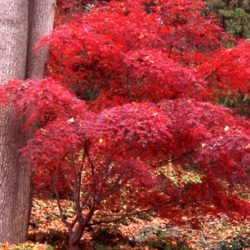
Japanese Maple
Sometimes only a single branch will turn color. This is a signal that the branch is injured or there is disease present. It can also be difficult to diagnose the difference between drought, an abiotic stress versus a biotic one (such as a pathogen or disease). Proper testing may be required as in the case of bacterial leaf scorch, which is a relatively new disease to our area affecting our oaks, maples, sycamores, London plane trees and elms.
An arborist can determine the source of the problem and suggest recommendations to rectify it before it develops further or results in the loss of the tree.
Ken Almstead is an ISA Certified Arborist and the CEO of Almstead Tree, Shrub and Lawn Care. (Almstead Tree, Shrub and Lawn Care, 15 Broadway, Hawthorne, 914.741.1510; www.almstead.com)
More Landscaping Tips from Ken Almstead here and here.
More from our Fall Survival Checklist
Sign up for the What To Do Email Newsletter … carefully curated for townies, culture-vultures, foodies and tree lovers


















